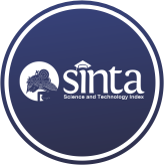Analisis Metode Clustering Pada Wilayah Berdasarkan Jenis Pencemaran Lingkungan Hidup
(1) Program studi Sistem Informasi, STIKOM Tunas Bangsa
(2) Program studi Sistem Informasi, STIKOM Tunas Bangsa
(3) Program studi Sistem Informasi, STIKOM Tunas Bangsa
(*) Corresponding Author
Abstract
This study uses a grouping model in determining areas based on the type of environmental pollution. This study is a special reference from the government in improving environmental sustainability. The data from this study was taken from the website of the government statistical data provider, BPS (Statistics Indonesia) www.bps.go.id. This research uses the K-Mens method and releases it with RapidMiner software to create 2 clusters, high and low level clusters and see what the contents of the cluster are. From the research results obtained by high cluster centroid data that is ((1527), (810.4), (5865), (6655.3), (323), (315.1)) low cluster namely ((139.25) , (122.5), (508,833), (919,222), (64,417), (94,444)). With this analysis, it is expected to be able to load and information for the government to pay more attention to regions whose income is still below average.
Full Text:
PDFReferences
D. D. A. N. Penanggulangannya and L. Warlina, “Pencemaran Air :,” pp. 1–26, 2004.
Cooper, “No 主観的健康感を中心とした在宅高齢者における 健康関連指標に関する共分散構造分析Title,” pp. 5–10, 2019.
A. Bastian et al., “Penerapan Algoritma,” Jsi.Cs.Ui.Ac.Id, vol. 14, no. 1, pp. 26–32, 2009.
D. N. Batubara, A. P. Windarto, D. Hartama, and H. Satria, “Analisis Metode K-MEANS Pada Pengelompokan Keberadaan Area Resapan Air Menurut Provinsi,” no. x, pp. 345–349, 2019.
DOI: https://doi.org/10.30645/kesatria.v1i1.10
DOI (PDF): https://doi.org/10.30645/kesatria.v1i1.10.g10
Refbacks
- There are currently no refbacks.
Published Papers Indexed/Abstracted By:














